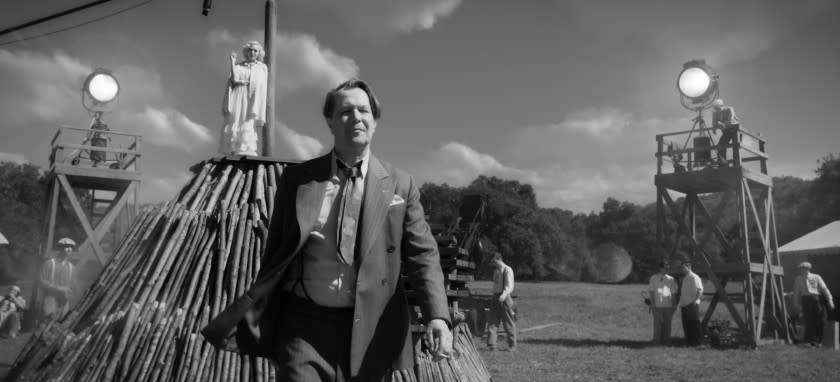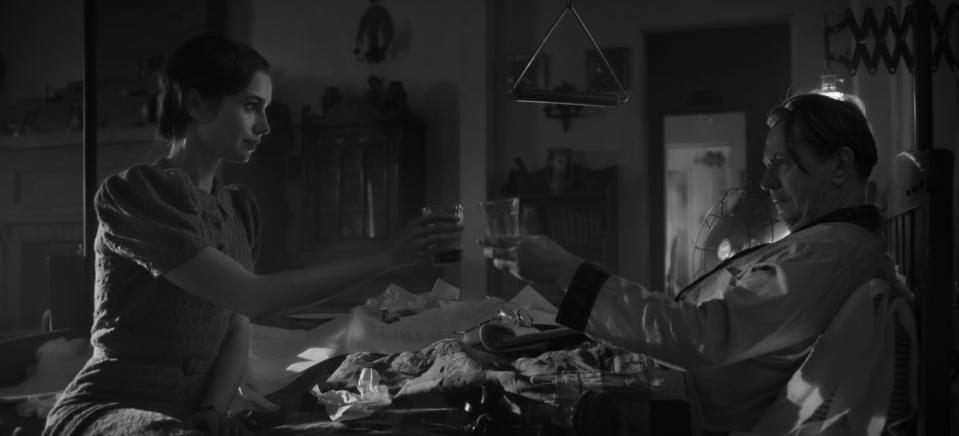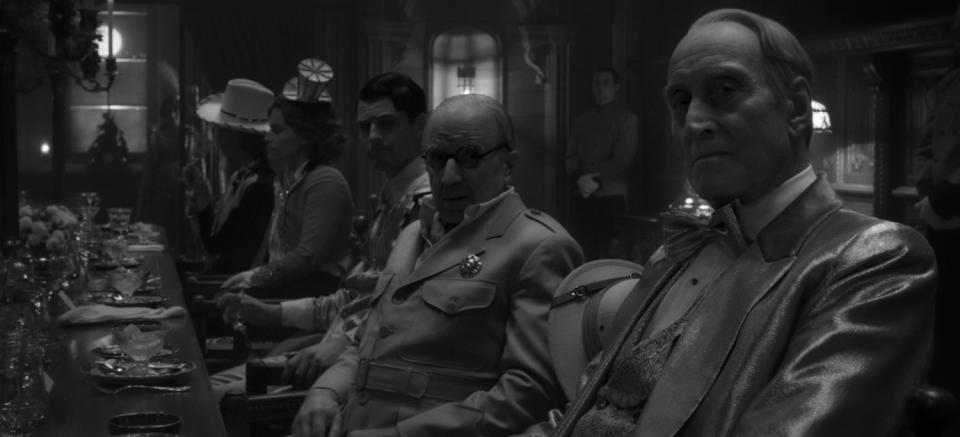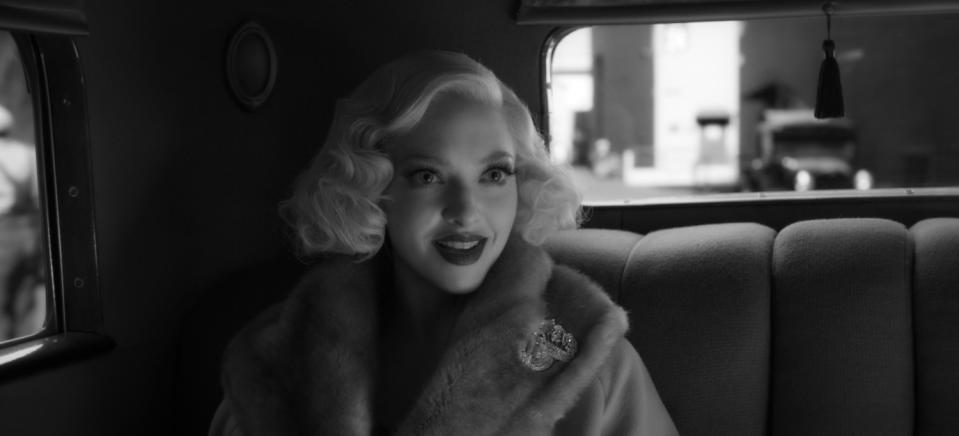Review: 'Mank' is a gorgeous dive into film history — and a sharp reflection on our political present

- Oops!Something went wrong.Please try again later.
The Times is committed to reviewing theatrical film releases during the COVID-19 pandemic. Because moviegoing carries risks during this time, we remind readers to follow health and safety guidelines as outlined by the Centers for Disease Control and Prevention and local health officials.
There is some awfully good writing in “Mank,” which is only to be expected for a movie about some of the finest writing ever to grace the silver screen. Under the circumstances, it seems fitting to quote a few examples. In one scene, the screenwriter Herman J. Mankiewicz (a superb Gary Oldman), laid up with a broken leg and a looming deadline, endures the lofty complaints of his editor, John Houseman (Sam Troughton). “You’re asking a lot of a motion picture audience,” Houseman says, describing Mank’s latest work as “a hodgepodge of talky episodes, a collection of fragments that leap around in time like Mexican jumping beans. The story is so scattered, I’m afraid one will need a road map.”
The screenplay under critique will eventually become “Citizen Kane,” and as dim as Houseman’s opinions may sound 80 years later, they’re a reminder of the sheer audacity of that 1941 masterwork, not only in its dazzling technique but also in its defiance of the constraints of linear narrative. And “Mank,” though hard-pressed to attempt anything comparably groundbreaking, nonetheless devises its own tricky, time-shuffling structure. Written years ago by Jack Fincher (who died in 2003), and directed with cool, characteristic discipline by his son, David Fincher, the movie is its own unapologetically talky, jumpy hodgepodge.
You won’t necessarily need a road map to follow the story as it shuttles between a guest ranch in 1940 Victorville, Calif., where Mank experiences his physical recovery and creative resurgence, and his bittersweet memories of 1930s Hollywood, re-created in all its cavernous grandeur, rat-a-tat repartee and profoundly rotten dealings. (The film does supply some nicely meta guideposts in the form of script-style scene headings.) A basic familiarity with “Citizen Kane,” or at least an ability to tell Orson Welles from H.G. Wells, should suffice, and if that’s asking a lot of an idle Netflix surfer, well, tough: In this dense, luxuriant cinephile swoon of a movie, you either sink or swim.

Which is not to suggest that “Mank,” shot in gorgeous black-and-white and oozing visual and verbal elegance from every pore, is explicitly about the making of “Citizen Kane.” Nor does it attempt a standard cradle-to-the-grave deconstruction of its eponymous hero; as Mank himself notes in a wryly self-reflexive touch, “You cannot capture a man’s entire life in two hours. All you can hope is to leave the impression of one.” And on that level, “Mank” more than succeeds. Its aim is to illuminate the prickly, endearing, booze-swilling soul of Herman J. Mankiewicz, a veteran drama critic who, like other brilliant men of letters who flocked to Hollywood in the 1920s, brought stiletto-sharp dialogue, airtight plot construction and astounding productivity to bear on a mass-entertainment medium.
Like many of his contemporaries, Mank often viewed that medium with barely concealed contempt, and the industry was happy to return it. There's no question whose side “Mank” is on, especially since Oldman invests the man with such rumpled grace, sozzled wit and bittersweet feeling. But the film is much more than a defense of the high-functioning alcoholic (though it is that), or a feature-length pity party for the high-minded scribe, toiling away in a hopelessly vulgar commercial medium. The Finchers, for all their pessimism about Hollywood, refuse to traffic in blanket cynicism, and the sheer density of detail they achieve reflects a palpably sincere affection for the medium and its history.
Their chief insight is that Mank’s brilliant way with words, on and off the page, elevated him to a privileged if short-lived position within the good graces of William Randolph Hearst (a splendidly reptilian Charles Dance), the newspaper tycoon whose life would inspire that of Charles Foster Kane. That position affords Mank a dispiriting front-row view of the ruthless operations of power — especially political power — in a film industry that, for all its much-vaunted liberalism today, is shown to be deeply in thrall to the Republican Party of the ’30s. Like a lot of writers, Mank is intuitively anti-establishment, and his Hollywood-insider years are depicted as a time of steadily mounting disillusionment with his colleagues' unswerving obedience to the GOP.

With a dry retort or a delicious putdown always at the ready, Mank bristles at the machinations of Hearst’s high-powered Hollywood friends, chiefly MGM’s Louis B. Mayer (Arliss Howard) and Irving G. Thalberg (Ferdinand Kingsley). They miss no opportunity to consolidate their authority and exploit their workers, whether during the belt-tightening struggles of the Great Depression or the high-wire strategizing of the 1934 California gubernatorial campaign. In that dramatic episode, Mayer, Thalberg and Hearst set out to torpedo the Democratic candidate Upton Sinclair (a nice cameo by Bill Nye), decrying his socialist views using phony newsreels: fake news avant la lettre.
This is rich, fascinating and inevitably painful material to contemplate in our era of conservative media moguls, anti-socialist rhetoric and, just in case you’d forgotten, electoral chaos. The never-distant scourge of anti-Semitism also gets a hat tip: Mayer and Thalberg’s blasé attitude toward the rise of European fascism in the early ’30s is pointedly rebuked, years later, by a passing mention of Mank’s own anti-Nazi resistance. (In 1935, Joseph Goebbels banned screenings of Mankiewicz-written films in Germany, the country from which Mank’s Jewish parents emigrated.) “Citizen Kane” is thus reframed as not just a personal work but an implicitly political one, a jab at Hearst the powerful puppetmaster and at Hollywood’s cold, capitalist heart of darkness.
Most of all, of course, it’s still a hell of a picture. The words “Citizen Kane” are never once uttered on-screen — it’s referred to by Mank’s working title, “American” — and the film itself is evoked mainly through visual, atmospheric associations. There are respectful salutes in the gorgeous filigree of Donald Graham Burt’s production design and Erik Messerschmidt’s high-definition digital cinematography, which mimics the look of old-school celluloid with intense chiaroscuro and faux reel-change marks. We never glimpse the Xanadu sets or Welles’ Mercury Theater players, but we do see Mank walking the grounds of Hearst’s estate, with its towering Gothic facades and monkey-crawling private zoo. (Who ever said San Simeon was sans simians?)

Strolling beside him in that sequence is the actress Marion Davies (a terrific, underused Amanda Seyfried), Hearst’s longtime love, whose enduring friendship with Mank lends the picture some of its sweetest, truest moments. His general companionability with younger women — his “platonic affairs,” in the exasperated words of his wife, Sara (Tuppence Middleton) — also emerges in his rapport with his nurse, Freda (Monika Gossmann), and especially his sharp-witted secretary, Rita Alexander (Lily Collins, an excellent foil). The tragic figure of Kane’s second wife, Susan Alexander, will be loosely inspired by Marion and partially named after Rita, and thus becomes a vivid argument that some of the most powerful fiction is rooted in lived experience.
That logic has given us some pretty reductive cause-and-effect artist biopics, but here it serves to deepen a complex inquiry into “Citizen Kane” and its own bitterly contested authorship. The critical contretemps that Pauline Kael ignited with “Raising Kane,” her passionate book-length argument that Mankiewicz was the originator of “Kane’s” Oscar-winning screenplay (for which he and Welles shared on-screen credit), can hardly be avoided. But “Mank,” an imaginative weave of scholarship and speculation, tiptoes deftly through that partisan minefield, celebrating its hero’s work without succumbing to Welles erasure. The astounding accomplishment of the 24-year-old genius who took Hollywood by storm is left to speak more than capably for itself.
This choice, which mostly relegates Welles (a brilliantly transfigured Tom Burke) to a jovial yet commanding presence at the other end of a telephone, comes at the expense of some deeper understanding of the writers' working relationship. But then, the title isn’t “Mank & Welles.” And its true subject is not just Mank, but the industry that he so loved and loathed. It stretches from Hearst’s palatial digs, where A-list luminaries swap bon mots by candlelight, to the writers’ room where Mank matches wits and gambles compulsively with other ace wordsmiths like George S. Kaufman (Adam Shapiro) and Ben Hecht (Jeff Harms).

The chatter is thick and wickedly diverting; the teeming backlots and snazzy parties are a people watcher’s delight. But beneath all that bubbly surface, the rules of the game are ruthless and unforgiving. Mank’s younger brother, Joseph L. Mankiewicz (Tom Pelphrey), warns him not to bite the hand that feeds him, briefly foreshadowing the very different Hollywood ascendancy that awaits him. A low-level film technician is ruthlessly exploited and ultimately discarded. Mank himself pays a steep price for his perceived disloyalty, retreating into an extended exile that becomes the staging ground for a history-making comeback.
That makes “Mank” very much a story about class divides and clashing egos, outsiders and insiders, striving and ambition, creation and authorship, and the thrill and loneliness of being the smartest guy in the room. It would make a particularly fascinating Mank-and-Mark double bill with Fincher’s “The Social Network,” which not coincidentally was greeted as the “Citizen Kane” of tech-whiz biopics. But while “Mank” shares some key Fincher collaborators (among them the editor Kirk Baxter and the composers Trent Reznor and Atticus Ross), it doesn’t have quite the same electrifying moment-to-moment verve. The off-kilter rhythms feel both immersive and agitated, as if Fincher were trying to both hypnotize you and jolt you awake with his lustrous Old Hollywood homage.
And why not? “Mank” demands your surrender, but also your heightened attention. It’s a pleasurably discombobulating experience, sometimes playing like mordant drawing-room comedy and sometimes flirting with expressionist nightmare, as when Welles’ dark silhouette looms over a bedridden Mank and his mummified leg. Sometime later, you could blink and miss the shot of a bottle falling from Mank’s grasp, a glibly funny “Kane” allusion that becomes both a portent of death and an affirmation of life. Kane died peering through a snow globe darkly; Mank succumbed to the bottle, but not until after he drank deep and churned his life’s passion into art.
This story originally appeared in Los Angeles Times.
